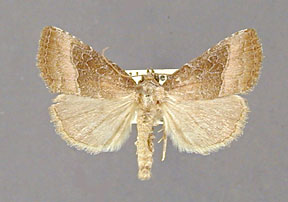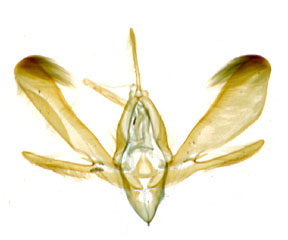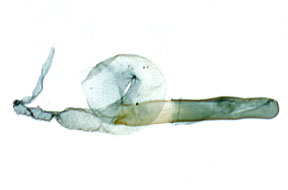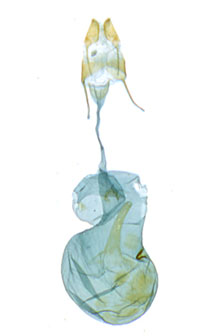
Ogdoconta cinereola


Male Genitalia

Female Genitalia
|
Ogdoconta Butler
Ogdoconta Butler, 1891, Ann. Mag. Nat. Hist.,
ser. 6, 7:462.
The genus Ogdoconta is a moderate size genus with its
largest concentration of species in the south-central and southwestern
United States, Mexico, and Central America. However species of the genus
occur throughout most of the New World, including the single species Ogdoconta
cinereola in the eastern United States and Canada. The species in
Ogdoconta are small to moderate in size and most of them are
not particularly distinctive superficially. There is no superficial character
that will always identify this genus. However there are characters in
both the male and female genitalia unique to Ogdoconta. The most
distinctive feature of the species in Ogdoconta is the divided
valve in the male genitalia. The saccular and cucullar regions are separate,
although joined at the base. In the female genitalia the appendix bursae
is wide and membranous and has one complete coil in it. The appendix bursae
is not distinctly separated from the ductus seminalis and the two cannot
be distinguished from each other. The larva has three SV3 setae on abdominal
segment I and in the male genitalia the vinculum and tegumen articulate
simply and directly as in Condica. Therefore this genus has been
placed in the Condicinae.
In addition to the species occuring in the United States and Canada, the
other described neotropical species of Ogdoconta are:
Ogdoconta lilacina (Druce)
Ogdoconta cymographa Hampson
Ogdoconta justitia Dyar
Ogdoconta plumbea Dyar Ogdoconta pulvilinea
Ogdoconta musculus (Schaus)
Schaus
In addition there are several undescribed species
from both Central and South America in the collection of the USNM.
Within North America north of Mexico the genus Ogdoconta breaks up into
three groups. The first group (here called the altura species
group) contains the four species altura, sexta, moreno,
and new species 1. All four of these species have nearly identical male
and female genitalia, although superficially only sexta and altura
appear superficially similar. This group has a simple valve without projections
of any kind on the outer margin. There is no clasper and the vesica of
the aedoeagus is elongate with a twist in it. In the female genitalia
the ostium is largely membranous with at most a small rectangular plate
in it. The corpus bursae is globular with a single internal signum. The
appendix bursae is large and coiled in accordance with the coil in the
vesica of the male genitalia. Also the junction between the appendix bursae
and the ductus seminalis is not obvious. The ovipositor lobes of these
four species are varicolored with light circles around the setal insertions.
Ogdoconta cinereola is peripherally a member of this group, but
shows some notable differences, in particular the presence of a clasper
at the junction of the saccular and cucullar regions of the valve of the
male genitalia. In addition the vesica of the aedoeagus has a complete
coil in it, while the vesicas of the four other species have a half or
three-quarters coil. The distribution of cinereola also falls
outside that of the first four species. Specifically cinereola
occurs throughout eastern North America, while the first four species
are confined to Texas or north-eastern Mexico. Outside of our region the
altura group also contains Ogdoconta muscula Schaus
and Ogdoconta pulvilinea Schaus as well as undescribed species.
The second group contains the single species, Ogdoconta new species
2 in North America. This species is characterized by a large projection
from the outer margin of the cucullar portion of the valve. The aedoeagus
is longer and thinner than in the members of the altura species
group. In the female genitalia the ostium is strongly sclerotized and
the sclerotization continues down the ductus bursae. The appendix bursae
is not coiled as in the altura species group and there is a distinct junction
between the end of the appendix bursae and the inception of the ductus
seminalis. Outside of our region the this group also contains Ogdoconta
plumbea as well as at least one undescribed species from Tamaulipas
in northern Mexico. The last group contains the North American species
Ogdoconta tacna. The outer margin of the valve in the male genitalia
is hatchet shaped and there are a series of projecting knobs. The vesica
of the aedoeagus has a row of short, stubby spines. In the female genitalia
the ostium and caudal half of the ductus bursae are strongly sclerotized.
The appendix bursae has a coil and the junction between it and the ductus
seminalis is not well marked. The most distinctive feature of tacna
is the strong rugose sclerotization of the appendix bursae and the general
region of the juncture of the ductus bursae, corpus bursae, and appendix
bursae. Outside of our region the tacna group also contains Ogdoconta
lilacina Druce and Ogdoconta justitia Dyar as well as a
number of undescribed species from both Central and South America.
|


